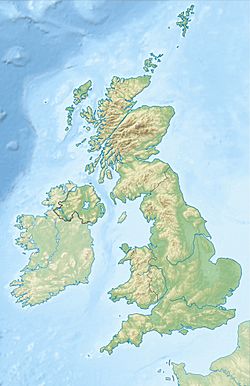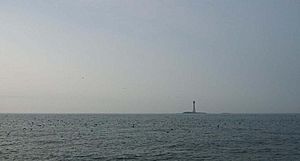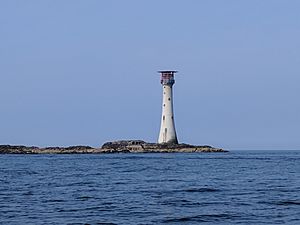Smalls Lighthouse facts for kids
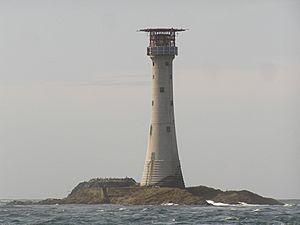 |
|
| Smalls Lighthouse in 2009 | |
|
|
|
| Location | The Smalls off Marloes Peninsula Pembrokeshire Wales |
|---|---|
| Coordinates | 51°43′16″N 5°40′11″W / 51.721239°N 5.669831°W |
| Year first constructed | 1776 (first) |
| Year first lit | 1861 (current) |
| Automated | 1987 |
| Construction | stone tower |
| Tower shape | tapered cylindrical tower with balcony, lantern and helipad on the top |
| Markings / pattern | unpainted tower |
| Height | 41 metres (135 ft) |
| Focal height | 36 metres (118 ft) |
| Current lens | 1st Order catadioptric |
| Intensity | 39,800 candela |
| Range | 18 nautical miles (33 km; 21 mi) |
| Characteristic | Fl (3) W 15s. (24h) |
| Admiralty number | A5278 |
| NGA number | 5600 |
| ARLHS number | WAL-023 |
The Smalls Lighthouse is a tall, strong building that helps ships find their way. It stands on a group of rocky islands called 'The Smalls' in the sea. These rocks are about 32 kilometers (20 miles) west of the Marloes Peninsula in Pembrokeshire, Wales. It's also about 13 kilometers (8 miles) west of Grassholm island.
This lighthouse was built in 1861 by an engineer named James Douglass. It replaced an even older lighthouse from 1776 that stood in the same spot. The Smalls Lighthouse is the furthest lighthouse from land that Trinity House, the group that looks after lighthouses in England and Wales, operates.
Contents
The First Smalls Lighthouse
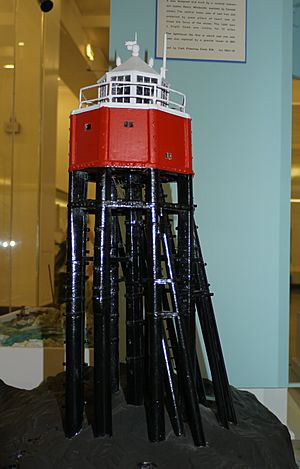
Building the First Lighthouse
The very first Smalls Lighthouse was built between 1775 and 1776. A merchant and shipowner from Liverpool, John Phillips, wanted it built. The plans were made by Henry Whiteside, who also made musical instruments.
This first lighthouse stood on nine strong oak pillars. This design allowed the powerful ocean waves to pass right through beneath it. At first, they thought about using cast iron for the pillars. However, they soon decided that English oak was better because it was more flexible and trustworthy. Even though the lighthouse sometimes rocked a bit, it stood strong for 80 years!
How the Light Worked
The light in the first lighthouse came from eight oil lamps. These lamps had special glass reflectors to make the light brighter. In 1817, they improved the light. They added twice as many lamps and used shiny silver parabolic reflectors. These new reflectors were much better at sending out a strong light.
Over the years, many extra supports were added to the original nine pillars. This type of pillar-based design has been used successfully in many other buildings in the sea since then.
A Message in a Bottle
In 1777, Henry Whiteside, the lighthouse designer, visited the Smalls Lighthouse. He got stuck there for a whole month because of very bad storms. Supplies were almost gone! He wrote a message to a friend in St. David's. He put the message in a bottle, inside a small box. He wrote a note asking whoever found it to send it to his friend. Just two days later, the bottle arrived almost at his friend's door!
The Smalls Lighthouse Incident
The old lighthouse is famous for a sad event in 1801, sometimes called the Smalls Lighthouse Tragedy. Two lighthouse keepers, Thomas Howell and Thomas Griffith, worked there. They were known to argue a lot. One day, Griffith died in an accident. Howell was worried that if he put the body into the sea, people might think he had murdered Griffith.
As Griffith's body started to decompose, Howell made a simple coffin. He tied the coffin to a shelf outside the lighthouse. But strong winds blew the box apart. Griffith's arm fell out and could be seen from the hut's window. When the wind blew, it would move the arm, making it look like it was waving.
Even with his former partner's body nearby and working all alone, Howell managed to keep the lighthouse lamp lit. When he was finally relieved from duty, the experience had changed him so much that his friends barely recognized him. Because of this difficult event, the rules for lighthouses changed in 1801. From then on, lighthouse teams had three people instead of two. This rule stayed until British lighthouses became automated in the 1980s.
The Smalls Lighthouse in Movies and Plays
The story of the Smalls Lighthouse incident has inspired several creative works:
- In 2011, a BBC Radio play called The Lighthouse was made. It was written by Alan Harris.
- The 2016 British film The Lighthouse, directed by Chris Crow, is also based on this event.
- The 2019 film The Lighthouse by Robert Eggers was also partly inspired by this tragedy.
1831 Storm Damage
In 1831, a huge wave hit the tower. It was so powerful that it ripped up the floor of the keepers' room! The floor was slammed against the ceiling, hurting all the keepers. One keeper was so badly injured that he died. However, the damage was fixed, and the lighthouse stood for another thirty years before it was replaced.
The Current Smalls Lighthouse
The new lighthouse was designed by James Walker, who was the main engineer for Trinity House. James Douglass was the chief engineer for the project. The first stone of the new tower was laid on June 26, 1857. Trinity House had bought the rights to the lighthouse in 1836. The new tower was finished in 1861.
In 1978, a helideck was built on top of the lighthouse, above the lantern. This allows helicopters to land there. In 1987, the lighthouse became automated, meaning no keepers were needed anymore. It was the first lighthouse in the United Kingdom to be powered by wind and solar energy. Even though its bulb is only 35 watts, its special lenses allow the light to be seen up to 34 kilometers (21 miles) away! It was also the first lighthouse in the country to have a flushing toilet installed.
The story of the Smalls Lighthouse was shown in the 2006 BBC Television programme Coast. It was part of Series 1, in the episode called "Bristol to Cardigan Bay".
The Smalls Lighthouse is important in the history of navigation. In 1837, an American captain named Thomas Hubbard Sumner made an important discovery. He was approaching Smalls Lighthouse in thick, foggy weather. He realized the idea of celestial position lines, also called the circle of equal altitude. These lines form the basis of almost all modern celestial navigation. They were sometimes called Sumner Lines after him.


